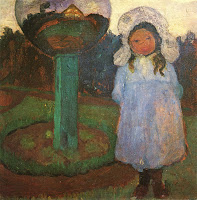 |
| A massive derecho swept through Yellow Springs, Ohio first week of class. |
Reading: “Chuang-tzu’s Essay on Seeing Things as Equal,” A. C. Graham, 1969
***How, if at all, does this essay relate to painting? Come to next class prepared to discuss this question, and others you may have.
A Very Concise Survey of Modern Painting
- Modern Art roughly 1860-1962 or 1980
- Shirking tradition
- Spirit of experimentation:
 |
| J. M. W. Turner |
- new ways of seeing
- new ways of using materials
- new functions for art
- tendency away from narrative, toward abstraction
19th century
Romanticism:
Francisco de Goya- (proto-symbolist)
J. M. W. Turner- (painter of light, “Turneresque” proto-impressionist)
Jean-Francois Millet- (Naturalism) exultation of peasants and their labors
Edouard Manet- affronting
propriety
-->
Impressionism: depiction of outer appearances (light, ephemera,
modernity, immediacy, movement, democratization of subject matter, en plein
air, overall visual effects versus detail, broken brushstrokes)
Mary Cassat- American expatriate
Post-Impressionism: Reject Impressionism's creative and expressive limitations and shallowness of
subject matter, and restore a sense of order to Impressionism
Henri de Toulouse Lautrec- contour, movement, influenced by
classical Japanese woodcuts (proto-Art Nouveau)
 |
| Georges Seurat |
Georges Seurat- Pointillism
Paul Cezanne- give order and structure to Impressionism, (the way he broke surface up into geometric shapes would inspire Cubism)
Vincent van Gogh- swirled and curled his brushwork to convey
feelings and states of mind
Symbolism: rejected realism and sought to create images that stood for big ideas
Edvard Munch- deeply psychological
James Ensor- Proto-Surrealist
Henri Rousseau- (Le Douanier), naïve style, primitive subjects
Paul Gauguin- sophisticated treatment of primitive subjects, proto-fauvist
20th century before WWI
Fauvism:colorful like Impressionism, but not based upon observation, and often dark outlines
Henri Matisse- innovative colorist and draftsman
Art Nouveau: Graphic, natural motifs, a reaction against academic art of the 19th century being decidedly decorative and blending with nature and life
Alphonse Mucha- (founder)
Aubrey Beardsley- Black ink drawings, erotic, grotesque, flowing
Aubrey Beardsley- Black ink drawings, erotic, grotesque, flowing
 |
| Henri Matisse |
 |
| Paul Gauguin |
Georges Braque- co-founder
Expressionism/German Espressionism:
Oskar Kokoschka- intensely psychological and emotional
Paula Modersohn-Becker- important ground-breaking early expressionist
Futurism: Italy (the future, technology, speed,movement, violence,
fascism, anti-liberalism)
Carlo Carra
Gino Severini
Art Deco:
Tamara de Lempika- Classic Deco style
Diego Rivera- Mexican Social Realist but in the Deco style
Synthetic Cubism: use of collage. intermix real fragments from reality with rendered ones.
Juan Gris
Pablo Picasso
Precisionism: (first indigenous U.S. modern-art movement) very clean line. flat interlocking planes reinterpret the american landscape of buildings, roads, and factories, and signs.
Charles Demuth- master of Precisionism
Suprematism: (the supremacy of pure artistic feeling)
Kazimir Malevich- simple black square to leave the viewer to ponder what is present in a painting that represents nothing else.
Olga Rozanova
Surrealism:
Giorgio de Chirico- His Metaphysical paintings inspired Surrealism.
Bauhaus: Sought to combine all the arts.
Paul Klee- playful humor, expressive, surreal, cubistic
Josef Albers- color theorist
De Stijl (neoplasticism): A utopian ideal of spiritual harmony and order achieved through pure abstraction.
Piet Mondrian- Searched for spiritual knowledge not through empirical means.
Theo van Doesburg- Primary theoretician of De Stijl.
20th century after WWII
Abstract Expressionism:
Jackson Pollock- Husband of Lee Krasner, drip painting, pure paint action, free of brushstrokes.
Lee Krasner- Wife of Jackson Pollock, Influential Ab-Ex painter
Color Field Painting:
Barnett Newman- or Post-painterly Abstraction "Zips"
Helen Frankenthaler- very thin paint on unprimed canvas
Proto-Pop:
Robert Rauschenberg- (combines) newspaper clippings and found objects attached to paintings (proto-bricolage (Postmodern))
Hard-Edge Painting:
Frank Stella- Shaped canvases, taped lines
Agnes Martin- reductive, grids
Minimalism:
 |
| Jackson Pollock |
Anne Truitt
Lyrical Abstraction: Moving away from the current trends, they reintroduced painterliness and expressive form to abstraction.
Ellsworth Kelly- expressive form
Nancy Graves- Her aerial views of the moon works were influential for future artists that also drew inspiration from aerial views.
Bay Area Figurative School: Abandoned Ab-Ex for a return to figural work.
Richard Diebenkorn
Joan Brown
-->
 |
| Helen Frankenthaler |
 |
| Robert Rauschenberg |
 |
| Agnes Martin |
 |
| Anne Truitt |
 |
| Nancy Graves |
 |
| Richard Diebenkorn |
 |
| Andy Warhol |
1962-1990: Post-Modernism: Bricolage (materials
close-at-hand), broken barrier between high and low art, recycling of
past styles into a modern context, appropriation, collage. Rejects the grand
narrative of Modernism.
Pop Art:
Andy Warhol-
Niki de Saint Phalle-
Op Art:
Bridget Reily-
Victor Vasarely-
 |
| Niki de Saint Phalle |
Postminimalism:
Eva Hesse-
Richard Serra-
Photorealism:
Audrey Flack-
Richard Estes-
Neo-Expressionism- 1980-90’s renewed interest in painting after the 1960-70’s witnessed a crisis in painting with the emergence of Land
Art, Performance Art, Conceptual Art, Installation Art, New Media Art. Hotly debated- revival of traditional
themes of self-expression in Europe after decades of American Dominance on one
hand, blatantly marketable return to painting, celebrity, backlash against
feminism and feminist themes, anti-intellectualism, return to mythic subjects and individualist
methods deemed outmoded- lacking interactivity, anti-minimalist.
Maria Lassnig
New Image Painting (American Neo-Expressionists)
Susan Rothenberg
Jean-Michel Basquiat
 |
| Eva Hesse |
 |
| Audrey Flack |
 |
| Anselm Kiefer |
 |
| Maria Lassnig |
 |
| Jean-Michel Basquiat |











No comments:
Post a Comment